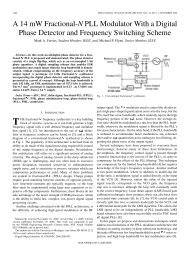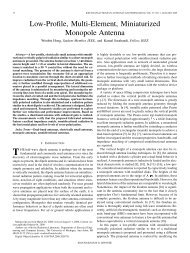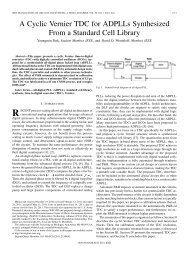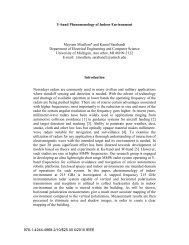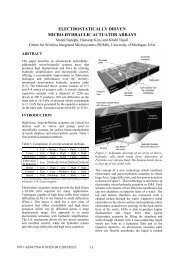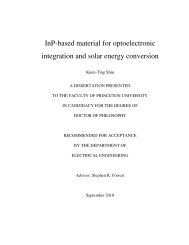Subwavelength Radio Repeater System Utilizing ... - IEEE Xplore
Subwavelength Radio Repeater System Utilizing ... - IEEE Xplore
Subwavelength Radio Repeater System Utilizing ... - IEEE Xplore
- No tags were found...
Create successful ePaper yourself
Turn your PDF publications into a flip-book with our unique Google optimized e-Paper software.
2688 <strong>IEEE</strong> TRANSACTIONS ON ANTENNAS AND PROPAGATION, VOL. 59, NO. 7, JULY 2011TABLE IIIDESIGNED PARAMETERS OF THE SMALL RADIO REPEATERFig. 10. Simulated radiation pattern: (a) single ground plane without isolator;(b) separated ground planes without isolator; (c) single ground plane withchannel isolator.Fig. 9. Simulated S-parameters of the small radio repeater with and withoutthe metamaterial isolator.are optimized for the repeater to operate around 2.72 GHz andare reported in Table III. The optimized simulation responseand measured data are discussed in Sections IV and V.IV. REPEATER SIMULATION RESULTSIn this section full-wave analysis is carried out to examinethe performance of the proposed repeater. Fig. 9 shows the simulatedS-parameters of the optimized small radio repeater platform.As shown, a 20 dB of transmission coefficient can beachieved between the TX and RX antennas without the channelisolator with designed dimensions (assuming the two antennasare well matched.) Incorporating the channel isolator, the transmissioncoefficient drops to 30 dB. Also shown is that the antennaresponse is affected due to the interaction between the antennasand the isolator. In fact, per our design the antennas arewell matched (over 15 dB of input reflection coefficient), andthe center frequency is at the desired value in the presence ofthe isolator. The presence of the antenna also affects the isolatorfrequency response. As shown before, the resonant frequency ofan isolated unit cell of the metamaterial isolator is at 2.98 GHz.With some small adjustments, in the presence of the antenna,this resonance occurs at 2.72 GHz as shown in Fig. 9.It should be noted here that if the ground planes of transmitand receive antennas are disconnected improved isolation canbe achieved. However, this way no amplifier can be insertedbetween the transmit and receive antennas.The simulated radiation patterns in H plane are representedin Fig. 10. In order to provide enough area for two modifiedantennas and a channel isolator, the ground plane should be extendedalong the longitudinal direction, which breaks the symmetryof the ground plane. Although the modified MMA withsquare ground plane shows pure vertical polarization in H plane(see Fig. 4(d)), the horizontal induced current on the rectangularground plane generates horizontal polarization in H plane asshown in Fig. 10(a). In all cases, however, the antenna showsaround 9 dBi of gain in vertical polarization. The gain ofthe antenna is limited due to dielectric and metallic losses. Increasingthe dielectric thickness and increasing antenna dimensionsincrease the gain. Also it should be noted that the distancebetween two antennas is about 25 mm. For such small separations,the coupling mainly comes from the antennas’ near field.Fig. 11 shows the magnetic field distribution over the groundplane for the repeater with and without the isolator. As expected,the horizontal magnetic field generated from the lower antennain Fig. 11(a) propagates through the substrate and produces themutual coupling to the top antenna. When incorporating thechannel isolator, Fig. 11(b) indicates that the horizontal magneticfield is maximized within the channel isolator. This impliesthat the surface currents (perpendicular to the direction ofmagnetic field in the channel isolator) are interrupted by the isolator,as shown in Fig. 12.V. EXPERIMENTAL RESULTSThe prototype of the proposed small radio repeater systemis fabricated using a 1.57 mm-thick Rogers RO-5880 substrate, as shown in Fig. 13. Fig. 14 shows the measuredS-parameters of the small radio repeater and indicates that theresonant frequency is located at 2.72 GHz. Since the fabricationprocess includes physical limitations such as under cutting


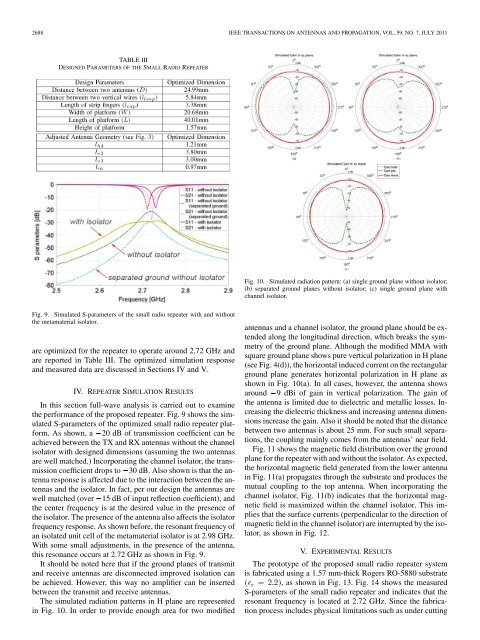
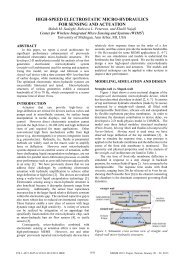
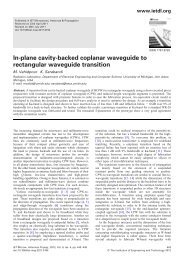
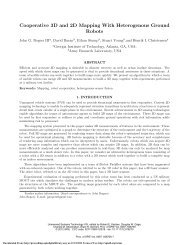
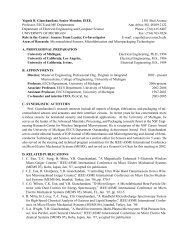
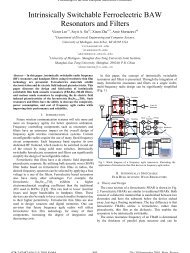
![[Sample B: Approval/Signature Sheet]](https://img.yumpu.com/34084789/1/190x245/sample-b-approval-signature-sheet.jpg?quality=85)
